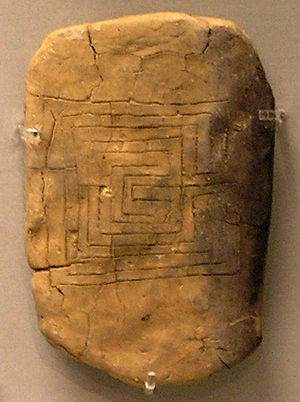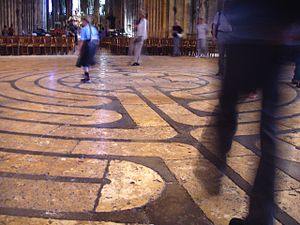
Dream Job
Sometimes as a designer, a dream job drops into your lap! That happened recently with creating a labyrinth space for a client. I have always wanted to install a labyrinth and had designed one for a previous client but because of cost, the job fell through. For that client, I went on to do a fabulous installation of waterfalls, ponds, and terraces, but the labyrinth was not to be. Here finally, was my chance to design and install a labyrinth!

Labyrinth History
My current client requested a space to help with the healing process of losing a son, which started me on a journey of learning all about the lore of labyrinths, which I found have been in existence for thousands of years. Patterns for labyrinths have been found on old tablets and pottery dating back to 4000 BC, and this ancient pattern is found in many cultures around the world. It is said that labyrinths mimic the spirals of nature. A labyrinth is often looked upon as a womb – a place of safety and rejuvenation. It is seen as a place for the birthing of inspiration, understanding and creativity.

In Greek mythology, the Labyrinth was an elaborate structure designed and built by the legendary artificer Daedalus for King Minos of Crete at Knossos. Its function was to hold the Minotaur, a mythical creature that was half man and half bull and was eventually killed by the Athenian hero Theseus. Daedalus had so cunningly made the Labyrinth that he could barely escape it after he built it. Theseus was aided by Ariadne, who provided him with a skein of thread, so he could find his way out again.

Labyrinth is generally synonymous with maze, but there is a distinction between the two: maze refers to a complex branching puzzle with choices of path and direction; while a single-path labyrinth has only a single, non-branching path, which winds to the center. A labyrinth has an unambiguous route to the core and is not designed to be difficult to navigate. It is all about the journey to the center of the labyrinth and a traveler is to walk it with intent and purpose. The path taken is for personal, psychological, and spiritual transformation.
Heart Space
To start your journey, a visit to the Heart Space which is the entrance to the labyrinth, is the first stop. I designed this as an antechamber to the main labyrinth with a small boulder water feature. The Heart Space may be used for the placement of any symbol that may enhance the spiritual use of the labyrinth. As a walker, you could dip your hand in the water to start the journey.

Center
To break the walker’s journey, I wanted a perching boulder that you could rest on. I looked for the perfect size and shape to place in the center. I didn’t want the boulder to be too large and over power the space which was 5 feet in diameter, but wanted something to enhance the journey.
Design Process at the Site

Since the site was sloping, I knew that a retaining wall had to be built into the hillside to hold the slope, and the entire area had to graded flat with a very slight incline towards the lane for drainage. With these parameters in mind, I measured the space that would accommodate a deceptively simple design that utilized the space available. Also large field stone steps would have to be placed in the hillside from the upper area down to the labyrinth.

I chose a cruciform design (turns in each quadrant), or a Contemporary Medieval design, which is a simplified version of the Chartres Labyrinth found at Chartres Cathedral in Paris. Old examples of these Medieval designs are found on the floors of Cathedrals of Europe. I ordered a template of white landscape cloth online as the design had to be installed precisely in stone.


Materials
I looked at many materials when planning the design but ultimately decided on one of my favorites, Bluestone. Sandstone was considered, but ultimately because of its habit of shedding layers since it is a soft stone, I discarded the idea of using it. Some labyrinths are made of turf set with stone, but already having known and taken care of this kind of labyrinth, eliminated this because of high maintenance. I just remember the weeds over growing the lines and the maintenance of always clearing them off.



Thank you for sharing my article. Yours was awesome, what a beautiful space! Some day I would love to build one. You did an amazing job with a small space. I hope you have had the chance to walk your creation.
I have very briefly. Once the weather is nicer,I will definitely take the time to do it.
Excellent – isn’t it good to see that labyrinths are alive and flourishing in the 21st century
It seems that there is a ressurgence of interest.
We have purchased four acres on a lake to build our final home. Have already set the stake for our walking labyrinth. This article is outstanding. Thank you for sharing.
Good luck! You don’t have to go all out and have it made in stone. I have seen beautiful ones with rounded stones laid into sod for the design.